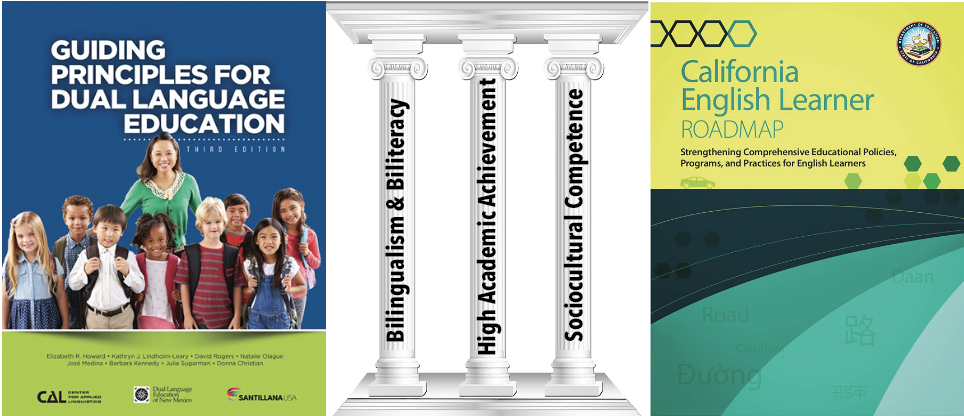Module 1: Foundations for a Strong, Successful, and Sustainable Dual Language Program
Provides a firm foundation in the basics of dual language education. Focuses on the importance of engaging families and community members in creating and sustaining bilingualism/biliteracy, high academic achievement, and sociocultural competence. Shares strategies for ensuring equity for all and the importance of having a language allocation plan, high‐quality standards‐based curriculum, and assessment and accountability practices that reflect the uniqueness of a dual language program.
Presented in English
September 9, 2023
Module 2: Best Practices in dual Language Education | Las mejores prácticas para la educación en dos idiomas
Provides a firm foundation in understanding and implementing the best instructional practices that will ensure student’s bilingualism/biliteracy and high academic achievement in both Spanish and English. Addresses the unique needs and best instructional practices of a Spanish biliteracy program. Offers ideas and concrete examples of ways teachers can create a highly effective learning environment that values the cultural and linguistic assets that all students contribute to the classroom community and supports their development of sociocultural competence.
Presented in Spanish (No interpretation in English available)
October 7, 2023
Module 3: Becoming a Reflective Dual Language Teacher
Outlines a teacher reflection system based on the Key Points from the Guiding Principles for Dual Language Education, 3rd edition, and aligned with the California English Learner (EL) Roadmap to support the reflection process of classroom teacher. Builds teachers’ capacity in implementing a high‐quality dual language program within their classrooms and developing their leadership skills to advocate for a strong dual language program. Supports teachers in identifying next steps to move toward higher levels of practice in support of all the language learners in their classroom.
Presented in English
November 4, 2023
Module 4: Authentic Spanish Reading Instruction | La pedagogía para la enseñanza auténtica de la lectura
Provides Spanish dual language teachers opportunities to engage in a contrastive analysis between initial literacy instruction pedagogy in English and Spanish, which will enhance their sociocultural competence when teaching students who are either native speakers of Spanish or Spanish Learners. Introduces research‐based instructional methods appropriate for teaching literacy in Spanish. Makes connections to the California CCSS en español and California Spanish Language Development Standards. Provides model lessons and resources for immediate classroom application.
Presented in Spanish (No interpretation in English available)
December 2, 2023
Module 5: Academic Spanish Language Development for Dual Language Teachers | El desarrollo del español académico para maestros de doble idioma
Equips teachers in biliteracy programs with high leverage instructional tools to develop student’s academic language in both English and Spanish and to support both the teachers’ and their students’ sociocultural competence. Presents research‐based strategies teachers can utilize when planning using the California CCSS en español and California Spanish Language Development Standards or both Integrated and Designated Spanish Language Development (SLD). Presents teachers with multicultural resources that will facilitate students’ academic language development and highlight cross‐linguistic connections between the two languages. Allows for reflection on the value of home languages and the linguistic decisions bilinguals make in different contexts, thus enhancing their sociocultural competence. Delivers differentiated language development instruction as well as ways to assess students’ linguistic abilities to inform their instruction.
Presented in Spanish (No interpretation in English available)
January 27, 2024
Module 6: Spanish Grammar Instruction: The “What” and the “How” | La pedagogía de la enseñanza de la gramática en español: El “qué” y “cómo”
Focuses on the progression of key language skills as described in the California CCSS en español and California Spanish Language Development Standards. Presents and models research‐based instructional strategies to teach grammar, orthography, and conventions that will support students’ understanding of “how Spanish works.” Explores culturally relevant language resources to study language patterns and varieties and connect these to the development and importance of sociocultural competence. Gives teachers tools needed to create a language rich environment.
Presented in Spanish (No interpretation in English available)
March 9, 2024
Module 7: Cross‐Linguistic Transfer in a Dual Language Program | Las transferencias interlingüísticas en el programa de doble idioma
Focuses on identifying the language features and building a bridge between the Spanish and the English languages. Explores the difference between code‐switching, translanguaging, concurrent translation, and cross‐linguistic transfer. Uses mentor text to examine the subsystems of language that can be addressed through cross‐linguistic transfer strategies and how sociocultural competence can be embedded in cross‐linguistic transfer instruction. Gives teachers an opportunity to participate in interactive model lessons. Examines ways on assessing language formally and informally to support students’ biliteracy development and sociocultural competence development through cross‐linguistic transfer instruction.
Presented in Spanish (No interpretation in English available)
April 6, 2024
Module 8: Best Practices for Spanish Writing Instruction in a Dual Language Classroom | Las mejores prácticas para la enseñanza de la escritura en español en un aula de educación en dos idiomas
Emphasizes a comprehensive literacy approach and biliteracy model that presents different types of writing through the lens of the biliterate writer. Focuses on the stages of Spanish writing development, using the California CCSS en español and California Spanish Language Development Standards as guides to writing instruction and to help build sociocultural competence. Presents how to craft focused mini‐lessons that teach explicit Spanish writing strategies and embedding linguistic support for emergent bilinguals in the writing process. Shows how to use culturally relevant teacher‐created mentor text to model the writing process and the role that multicultural touchstone texts play in studying genre/text type, craft, and structures. Develops students’ awareness and ability to write for their readers and understanding of real‐life purposes for writing. Demonstrates how to differentiate instruction and support through small group and writing conferences while also assessing student writing through a biliteracy lens to guide instruction.
Presented in Spanish (No interpretation in English available)
May 4, 2024



